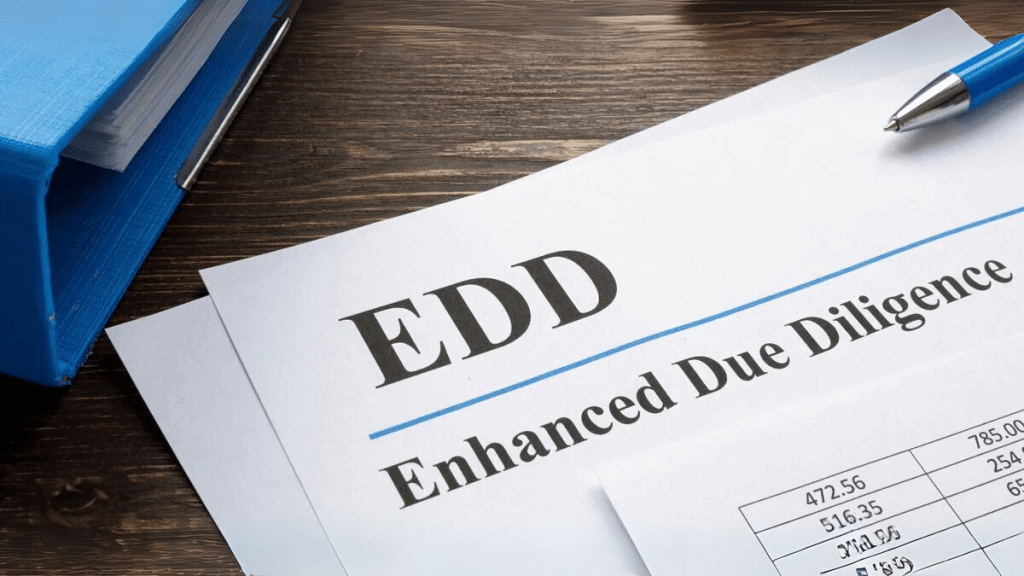In the field of compliance, Enhanced Due Diligence (EDD) plays a pivotal role within the broader Know Your Customer (KYC) framework. Unlike standard due diligence, EDD focuses on high-risk customers and transactions, ensuring adherence to anti-money laundering (AML) regulations and reducing the likelihood of financial crimes. However, implementing EDD effectively without straining resources is a delicate challenge. This article explores the intricacies of EDD, its distinction from standard due diligence, and its significance for financial institutions.
What is EDD?
Enhanced Due Diligence (EDD) is an advanced verification process aimed at evaluating the risk profiles of high-risk individuals or transactions. It goes beyond routine Customer Due Diligence (CDD) by conducting deeper investigations into customer identities, financial histories, and potential links to illicit activities such as money laundering or fraud.
EDD is crucial for preventing large-scale financial misconduct. For example, the 1MDB scandal—a $4.5 billion fraud scheme—highlights the importance of rigorous due diligence in safeguarding financial systems.
What is the difference between customer due diligence and enhanced due diligence?
Customer Due Diligence (CDD) is the standard procedure for verifying a customer’s identity and assessing their risk level. CDD typically involves:
- Collecting and verifying identification documents.
- Screening for potential red flags, such as ties to politically exposed persons (PEPs) or sanctioned individuals.
- Monitoring transactions for unusual patterns.
In contrast, Enhanced Due Diligence (EDD) applies to high-risk customers and involves:
- Comprehensive investigations into the source of funds and wealth.
- Analysis of beneficial ownership to uncover hidden entities.
- Enhanced monitoring of high-value or unusual transactions.
- Regular updates to risk profiles.
While CDD suffices for low- to moderate-risk customers, EDD is indispensable for high-risk cases to avoid compliance breaches, reputational harm, and legal liabilities.
Who needs Enhanced Due Diligence and when?
EDD is selectively applied based on risk assessments and regulatory requirements. It is typically necessary for the following categories:
- Politically Exposed Persons (PEPs): High-ranking officials, military leaders, or executives of state-owned enterprises, who pose elevated risks of bribery and embezzlement.
- Customers in High-Risk Jurisdictions: Those operating in regions with weak AML frameworks or international sanctions.
- Entities with Complex Ownership Structures: Shell companies or trusts designed to obscure beneficial ownership.
- Customers with Adverse Media Reports: Individuals or entities associated with criminal or unethical activities.
- High-Value Transactions: Sudden spikes in account activity or involvement in industries prone to money laundering, such as art or precious metals.
How does the enhanced due diligence process work?
The EDD process involves several stages designed to mitigate risks effectively:
Step 1: Identifying High-Risk Customers and Transactions
Financial institutions assess risks during customer onboarding or upon detecting anomalies in existing accounts. Screening tools compare customers against sanctions lists, adverse media reports, and PEP databases.
Step 2: Gathering Additional Information
For high-risk customers, institutions collect detailed information, such as:
- Source of funds and wealth (e.g., tax returns, investment records).
- Beneficial ownership details for entities with complex structures.
- Customer intent regarding transactions or business relationships.
Step 3: Reporting Suspicious Activities
If irregularities arise, institutions must file a Suspicious Activity Report (SAR) with the relevant authorities. Otherwise, the customer proceeds with onboarding and enhanced monitoring.
Step 4: Implementing Enhanced Monitoring Systems
Transaction monitoring software detects unusual patterns and updates risk profiles to address emerging threats.
Step 5: Document Retention
Institutions retain records of EDD activities for at least five years, including identification documents, verification results, and flagged transactions.
Enhanced due diligence requirements
To meet EDD obligations, financial institutions must:
- Conduct Comprehensive Risk Assessments: Identify high-risk customers and transactions based on internal policies and regulatory standards.
- Utilize Advanced Screening Tools: Automate data collection and verification for efficiency.
- Perform Detailed Investigations: Investigate beneficial ownership, sources of funds, and potential risks thoroughly.
- Implement Continuous Monitoring: Use sophisticated tools to track activities and update risk profiles dynamically.
- Maintain Accurate Records: Keep comprehensive documentation of all EDD processes to ensure compliance and facilitate audits.
Conclusion
Enhanced Due Diligence is an essential part of the Know Your Customer framework, offering a robust mechanism to scrutinize high-risk customers and mitigate financial crime risks. By understanding the differences between EDD and CDD, institutions can deploy effective strategies that balance compliance with operational efficiency. Leveraging advanced technologies—such as automated ID verification and transaction monitoring—helps organizations streamline EDD processes, protecting both their reputation and the integrity of financial systems.
